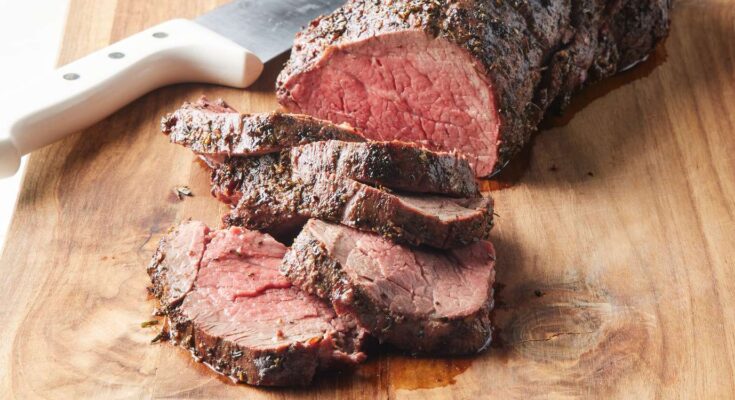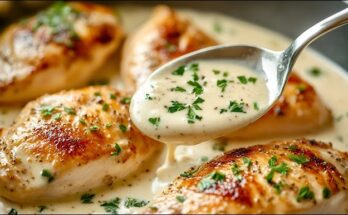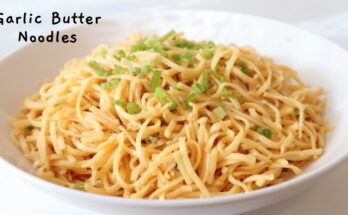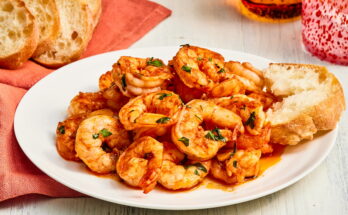Beef Tenderloin Steak Recipe: Beef tenderloin is like the Rolls Royce of steaks—it’s all about class, quality, and that velvety soft texture. This cut is from the loin section of the cow and is known for being ultra-tender because it comes from a muscle that doesn’t get much exercise. That’s also why it’s one of the priciest cuts on the market.
So, why pick beef tenderloin over other cuts like ribeye or sirloin?
Well, it’s the leanest and most tender part of the cow. While it doesn’t have as much marbling as a ribeye, when cooked correctly, it’s buttery, flavorful, and juicy without being greasy. It’s the kind of steak that doesn’t need much fuss—just a bit of salt, pepper, heat, and patience.
If you’re cooking for someone special or just want to treat yourself, beef tenderloin steak is the way to go. It cooks quickly and delivers premium results every single time.
What Makes This Cut So Special?
Beef tenderloin stands out for several reasons beyond just its tenderness. It’s a boneless cut, making it super easy to work with. Plus, it’s incredibly versatile. You can roast it whole for a celebration dinner or slice it into steaks for a fast, flavorful meal.
Another reason it’s so beloved is the texture. Imagine slicing into a steak with a butter knife—that’s beef tenderloin for you. It’s smooth, luxurious, and practically melts in your mouth. While it doesn’t pack the beefiest flavor (due to less fat), it makes up for that with elegance and consistency.
Pair it with a rich sauce or a bold seasoning blend, and you’ll understand why chefs worldwide adore this premium cut. It’s the kind of steak that instantly makes dinner feel like a five-star experience.
List of Ingredients You’ll Need
A great steak doesn’t need a laundry list of ingredients. The magic lies in simplicity. Here’s what you’ll need to get started:
Basic Ingredients
- Beef Tenderloin Steaks – 2 pieces, about 6-8 oz each
- Kosher Salt – 1 to 2 tsp, for seasoning
- Freshly Ground Black Pepper – 1 tsp
- Olive Oil – 2 tbsp
- Unsalted Butter – 2 tbsp
- Garlic Cloves – 3, smashed
- Fresh Rosemary or Thyme – 2 sprigs
Optional Add-ons for Flavor
- Crushed Red Pepper Flakes – for heat
- Steak Seasoning Blend – if you prefer extra flavor
- Shallots – diced, for added sweetness
- Balsamic Vinegar or Worcestershire Sauce – for depth
- Mushrooms – for an earthy side option
These ingredients can be mixed and matched to suit your preferences. The goal is to complement, not overpower, the star of the show—the beef tenderloin steak.
Kitchen Tools & Equipment Checklist
To make the cooking process smooth and efficient, it’s best to gather everything you need ahead of time. Here’s your essential checklist:
- Cast iron skillet or heavy-bottomed frying pan
- Meat thermometer
- Tongs
- Cutting board
- Sharp chef’s knife
- Aluminum foil (for resting)
- Oven mitts
- Small bowl for seasoning mix
- Basting spoon
Having the right tools on hand will make all the difference when timing and temperature are critical for a perfect sear.
How to Choose the Perfect Beef Tenderloin
Not all tenderloins are created equal. When shopping for beef tenderloin steaks, look for:
- Bright red color – indicates freshness
- Firm texture – the meat should bounce back when pressed
- Minimal connective tissue – fewer tendons means easier prep
- Even thickness – helps with uniform cooking
- Grading matters – USDA Prime is best, followed by Choice
If you’re buying whole tenderloin to cut at home, choose one labeled “peeled” or “PSMO” (peeled, side muscle on). This gives you more flexibility to portion it the way you want.
Preparing the Meat: Cleaning and Trimming Tips
Prepping the steak is where many people go wrong. A little care here makes a huge difference.
- Remove the silver skin – This tough, shiny membrane doesn’t break down during cooking and will ruin your texture.
- Trim excess fat – You want some fat for flavor but not too much.
- Pat it dry – Use paper towels to remove surface moisture. A dry steak gets a better crust.
- Tie it up (optional) – For even thickness, use kitchen twine to shape the steak into a more uniform round.
Don’t skip these steps! Proper preparation is the secret to that steakhouse finish.
Marinating vs. Dry Rub – Which is Better?
This is a debate that never ends in the steak world. Should you marinate your beef tenderloin or stick to a simple dry rub? Let’s break it down.
Marinating: Yay or Nay?
Beef tenderloin is already so tender that marinating it for tenderness is completely unnecessary. However, if you want to infuse your steak with bold flavors—like garlic, soy, or balsamic vinegar—a marinade can add complexity. Just make sure not to overdo it. The cut is delicate, and too much acidity can start to “cook” the meat (like ceviche), affecting texture.
Recommended Marinade (optional):
- 2 tbsp soy sauce
- 1 tbsp olive oil
- 1 tsp minced garlic
- 1 tsp balsamic vinegar
- Black pepper
Let the steak soak for no more than 30–60 minutes in the fridge.
Dry Rub: The Simpler, Better Way
In most cases, a dry rub is your best bet. Salt and pepper alone are enough to elevate the flavor, especially when you’re searing with butter, garlic, and herbs. A dry rub also allows for a crisp, flavorful crust that locks in juices.
- Simple Dry Rub Recipe:
- 2 tsp kosher salt
- 1 tsp freshly cracked pepper
- ½ tsp garlic powder
- ½ tsp smoked paprika
Rub generously on all sides, and let the steak rest for 15–20 minutes before cooking to allow the seasoning to absorb.
How Long Should You Let It Sit Before Cooking?
Letting your steak come to room temperature before it hits the pan is non-negotiable.
Cold steak + hot pan = uneven cooking. That’s the truth.
Take your tenderloin steaks out of the fridge about 30–45 minutes before cooking. This gives the meat time to relax, ensuring a more even cook throughout and better moisture retention. During this time:
- Pat it dry again if needed
- Apply your dry rub or simple salt/pepper combo
- Let the meat “breathe” on the counter on a wire rack or plate
Doing this one simple thing can be the difference between a medium-rare center and an undercooked middle with overcooked edges.
Pan-Searing vs. Grilling – Which Cooking Method Wins?
Both methods can give you excellent results, but your choice depends on what you’re after and what tools you have.
Pan-Searing + Oven Finish (Best for Home Cooks)
Pan-searing in a hot cast-iron skillet gives you a deep, caramelized crust. Finish it in the oven to cook the inside gently and evenly. This method gives you full control over your steak’s texture and doneness.
Pros:
- Precise control
- Great crust
- Easy to baste with butter, garlic, and herbs
Grilling
Grilling adds a smoky flavor and is great for outdoor cooking. However, maintaining consistent heat and getting an even sear can be tricky if you’re not used to your grill.
Pros:
- Smoky, charred flavor
- Ideal for summer or large portions
- Quick cooking
If you’re going for perfection—go with pan-sear + oven finish. Want that smoky BBQ touch? Grill away.
Step-by-Step Guide: Cooking Beef Tenderloin Steak
Now let’s get into the action. This foolproof, step-by-step guide ensures a restaurant-worthy steak every time. We’ll use the pan-sear then oven-finish method, which is ideal for cooking 6 to 8 oz steaks.
Step 1: Bring Meat to Room Temperature
Take the beef tenderloin steaks out of the refrigerator about 30–45 minutes before cooking. Allowing them to reach room temperature ensures even cooking from edge to center.
Step 2: Season Generously
Pat the steaks dry, then season both sides liberally with salt, cracked black pepper, and a touch of garlic powder or rosemary. Simple seasoning lets the natural flavor of the beef shine.
Step 3: Heat the Pan Correctly
Preheat a cast-iron skillet or heavy pan over high heat until it’s almost smoking. Add a bit of oil with a high smoke point, like canola or avocado oil.
Step 4: Sear on Both Sides
Place the steaks in the hot pan and sear for 2–3 minutes per side until a golden crust forms.
Step 5: Finish in Oven or Pan
For medium-rare, transfer the pan to a 400°F (200°C) oven for 5–7 minutes, or lower the heat and finish on the stovetop.
Step 6: Rest the Steak Before Cutting
Remove and rest for 5–10 minutes. This redistributes juices, ensuring your tenderloin stays perfectly moist and melt-in-your-mouth delicious.
Temperature Guide for Perfect Doneness
Knowing the internal temperature is the key to steak mastery. Here’s your cheat sheet:
| Doneness | Internal Temp | Appearance |
|---|---|---|
| Rare | 120–125°F | Cool red center |
| Medium Rare | 130–135°F | Warm red center |
| Medium | 140–145°F | Pink center |
| Medium Well | 150–155°F | Slightly pink to brown center |
| Well Done | 160°F+ | Fully brown, no pink |
Pro Tip: Use an instant-read thermometer and insert into the thickest part of the steak for the most accurate reading.
Best Side Dishes for Beef Tenderloin Steak
A perfectly cooked beef tenderloin steak deserves sides that elevate its rich, buttery flavor. While you don’t want anything that overpowers the steak, the right accompaniments can transform your meal from great to unforgettable.
Classic Side Dishes to Serve:
- Garlic Mashed Potatoes
Creamy, buttery, and rich—mashed potatoes are a timeless pairing. Add roasted garlic and a dash of sour cream for extra depth. - Roasted Asparagus
Light, slightly crunchy, and earthy, asparagus is the ideal green side for a heavy main. Drizzle with olive oil, season with salt and pepper, and roast for 10–15 minutes at 425°F. - Creamed Spinach
A steakhouse classic, creamed spinach is velvety and full of flavor. It brings creaminess and color to the plate. - Grilled or Roasted Mushrooms
Mushrooms and steak are best friends. Sauté in butter and garlic or roast them with thyme for a meaty, umami-packed side. - Herb Butter Dinner Rolls
You’ll want something to mop up those juices and pan sauce—and soft, warm rolls do the job perfectly. - Red Wine Reduction Sauce
If you’re not pairing it with a creamy side, a simple red wine sauce made from pan drippings can balance the richness of the steak.
Mix and match based on your dinner vibe—whether it’s a romantic meal, holiday gathering, or casual dinner.
Sauce Ideas to Elevate Your Dish
While beef tenderloin can stand on its own, a well-crafted sauce adds sophistication and flavor that takes things to the next level. Whether you’re into creamy or tangy, there’s a sauce to match your taste.
1. Red Wine Pan Sauce
This is a go-to for tenderloin lovers. After searing your steak, don’t clean the pan—those brown bits at the bottom are gold.
Ingredients:
- 1/2 cup red wine
- 1/4 cup beef stock
- 1 tbsp butter
- 1 clove garlic, minced
- Fresh thyme
Instructions:
Deglaze the pan with wine, scrape the bottom, add stock and garlic. Let it simmer and reduce by half. Finish with a pat of butter and herbs.
2. Garlic Herb Butter
Mix softened butter with minced garlic, parsley, and a bit of lemon zest. Place a dollop on the hot steak before serving. It melts into the meat and gives it a decadent finish.
3. Peppercorn Cream Sauce
Love a kick? Try this creamy, slightly spicy sauce.
Ingredients:
- 1/2 cup heavy cream
- 2 tsp crushed black peppercorns
- 1 tbsp cognac or brandy
- Salt to taste
Simmer in a saucepan until thickened and pour over your steak.
4. Béarnaise Sauce
This French classic is egg-based and infused with tarragon, vinegar, and shallots. It’s fancy, flavorful, and pairs beautifully with tenderloin.
5. Horseradish Cream Sauce
For a zesty punch, mix sour cream, grated horseradish, lemon juice, and chives. It cuts through the richness of the meat without overpowering it.
Common Mistakes to Avoid
Even with a high-quality cut like beef tenderloin, a few missteps can sabotage your steak. Here’s what NOT to do:
1. Cooking Cold Steak
Never toss a steak straight from the fridge into a hot pan. It will cook unevenly and turn out rubbery or raw in the center. Always bring it to room temperature.
2. Skipping the Rest Time
Cutting into your steak right after it’s done is like opening a soda that’s been shaken—everything spills out. Resting for 5–10 minutes lets the juices redistribute.
3. Overcrowding the Pan
Don’t try to cook more than two steaks at a time unless your pan is huge. Overcrowding drops the pan temp and leads to steaming, not searing.
4. Forgetting to Use a Meat Thermometer
Guessing your steak’s doneness is a gamble. Use a thermometer for accuracy and confidence.
5. Overcooking
Beef tenderloin is lean—if you overcook it, there’s no fat to bail you out. Aim for medium-rare or medium max for best results.
Leftover Ideas: What to Do with Extra Steak
Got leftover tenderloin steak? First of all—lucky you. Second, here are some genius ways to reuse it:
1. Steak Sandwiches
Slice thin and layer on a crusty baguette with arugula, caramelized onions, and horseradish mayo. Boom—gourmet lunch.
2. Steak Salad
Toss greens, cherry tomatoes, avocado, blue cheese, and thin steak slices. Add a vinaigrette for a light yet satisfying meal.
3. Steak Tacos
Warm up tortillas, add beef strips, slaw, and chipotle crema for next-level tacos.
4. Steak & Eggs
Pan-fry some eggs and reheat your steak. Add toast or potatoes and you’ve got a power breakfast.
5. Stir-Fry
Cut the steak into strips and toss into a quick stir-fry with veggies and soy-based sauce.
Store leftovers in an airtight container in the fridge for up to 3 days, or freeze for longer use.
FAQs about Beef Tenderloin Steak Recipe
1. Can I cook beef tenderloin steak on the grill instead of a pan?
Absolutely! Just make sure the grill is preheated and super hot. Sear each side for 2–3 minutes and finish over indirect heat if needed.
2. How do I know when the steak is perfectly cooked?
Use a meat thermometer. Medium-rare is best at 130–135°F. Let it rest for 5–10 minutes after cooking.
3. Is it okay to marinate beef tenderloin overnight?
Not recommended. The cut is tender enough, and too long in an acidic marinade can mess with the texture. Keep it under an hour.
4. What’s the best wine to pair with beef tenderloin steak?
Full-bodied reds like Cabernet Sauvignon, Syrah, or Malbec complement the richness of the meat beautifully.
5. How do I reheat leftover steak without drying it out?
Wrap it in foil and warm it in the oven at 250°F for 10–15 minutes. Or slice and reheat gently in a skillet with butter.
Conclusion
Beef tenderloin steak is more than just a meal—it’s a culinary experience. With the right ingredients, tools, and step-by-step process, you can recreate that steakhouse magic in your own kitchen. Remember, the key is simplicity. Let the natural flavor of the beef shine with minimal seasoning and careful cooking.
So, whether you’re planning a romantic date night or a festive family dinner, this recipe has your back. Try it once, and you’ll want to make it your go-to special occasion dish every time.
Happy cooking—and even happier eating!



